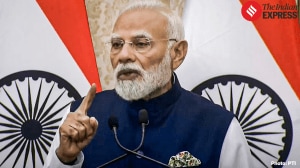Oval maidan is back into shape, regains stature too
MUMBAI, OCT 18: If Rajabai Tower is Mumbai's answer to the Big Ben, the way to it is Oval Maidan -- seen till today as a derelict ground ...

MUMBAI, OCT 18: If Rajabai Tower is Mumbai’s answer to the Big Ben, the way to it is Oval Maidan — seen till today as a derelict ground used as a shortcut between Churchgate and the University, and from today as a restored heritage precinct.
This evening, the Oval Cooperage Residents’ Association (OCRA) will formally throw open the Restored Oval Maidan, the result of its two-year efforts to reinstate the greater part of the Esplanade of the late 1860s — other remnants of this chapter of South Mumbai’s history being the Cross Maidan, Azad Maidan and the Cooperage. “Restoration of Oval Maidan is a first-rate specimen of focus on a heritage precinct rather than on an immediate neighbourhood,” says social activist and theatre personality Gerson da Cunha.
A beautifully green space once upon a time, Oval Maidan suffered colossal neglect over the years due to lack of imposition of rules and the government’s failure to exercise its authority to save the maidan. All that was left of it a couple of years ago was barren land, with an aerial view of 25-30 lanes running across. “I live on the Oval and know what a struggle it has been to protect it,” says da Cunha, who has 50-year-old memories of riding on the Oval. “Only when the OCRA institutionalised its efforts with the formation of Organisation for Verdant Ambience & Land Trust (OVAL) that things started to take shape,” he adds. OVAL is primarily funded by the Tata Trust, and the restoration work it has done has cost over Rs one crore.
“In our 15-year struggle, we have had to battle irrational government plans of building an athletic tract, a stadium, a shopping mall and six ramps by cutting the Oval to have an underground car park,” says Naina Katpalia, one of the seven OVAL trustees. “Then there were drug peddlers, commercial sex workers and vagrants encroaching upon the maidan. Also, the southern end of the ground was being used as a dumping ground. Around 250 truckloads of debris had to be removed,” she says. So, OCRA asked the government for permission to take care of the maidan. Saying no didn’t make sense, but since the state government, unlike the BMC, didn’t have the experience of giving land on sponsorship, the process took seven years.
When permission was obtained two years ago, OVAL got down to work. “Fencing was our priority, for after years of neglect, the fence was broken at a number of places,” informs Shireen Bharucha, an OVAL trustee. Then came the undulated ground, the walking tract, lighting, gates, grass and the planting of palm trees. “I can still see the palm-fringed Oval of the forties. It also had a riding-cum-walking tract, where I took riding lessons, and a boundary marked by pillars tied together with a chain,” says Katpalia. “It’s such a pleasure to see it restored to what it was in my childhood days,” exults theatre personality Pearl Padamsee, who used to cross the Oval to go to her school. “After a long period of neglect, it has finally come to look very beautiful,” she says.
“Rajabai Tower and the Oval have been two important symbols of Bombay,” says historian Sharda Dwivedi. “For years, I used to cross the Oval to go to the university for my library science lectures. The trips were such a pleasure. But with the government changing its development plans, rather than doing something to protect our heritage, the maidan went from bad to worse,” she adds.
Dwivedi’s publishing company, Eminence, has designed the brochures for today’s inauguration of the Oval. Also, the proceeds of the first day’s sale of her book, Bombay — the Cities Within, which amounted to Rs one lakh, went to the trust. “Just a drop in the ocean, considering that the OVAL needs crores to maintain the ground,” she maintains. Another drop in the ocean has been from Bombay Collaborative, a firm of architects including Rahul Mehrotra and David Cardoz, which has designed the renovated plan for free.
Besides the seven cricket pitches — something for which the maidan is known — that will be leased out, the Oval now has 200 palm trees, gates that will remain closed between 10.00 pm and 6.00 am, a walking tract, lights, regular water supply from the underground borewell and 24-hour security. “It’s an excellent example of what we should do for Mumbai as its citizens,” says da Cunha.



- 01
- 02
- 03
- 04
- 05




























